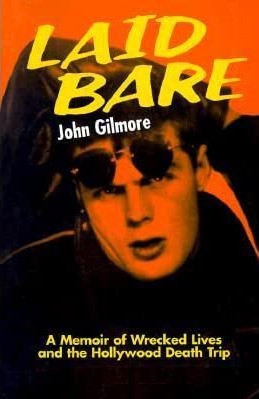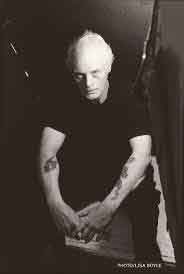 By JOHN GILMORE (Amok; 1997)
By JOHN GILMORE (Amok; 1997)
The nineties were something of a golden age for unflattering Hollywood exposes. It was then that producer Julia Phillips’ notorious autobiography YOU’LL NEVER EAT LUNCH IN THIS TOWN AGAIN, in which she savaged Steven Spielberg, David Geffen, John Milius and many other Hollyweird bigshots, appeared, as well as the two-volume YOU’LL NEVER MAKE LOVE IN THIS AGAIN, in which several prostitutes revealed intimate details about their celebrity clientele. Those books generated a great deal of attention, and controversy, in their day, but the decade’s most outrageous show-biz tell-all came and went with little fanfare of any sort: LAID BARE, a memoir by the late John Gilmore (1935-2016).
The nineties were something of a golden age for unflattering Hollywood exposes.
A pretty boy actor who later turned to true crime writing, Gilmore never attained much in the way of celebrity (the most likely reason this book was ignored by the mainstream). Yet according to his recollections here he was in touch with nearly every famous and (more importantly) soon-to-be famous person of the 1950s due to his friendship with James Dean, the decade’s preeminent movie star. Gilmore has written extensively about his relationship with Dean in other books (such as THE REAL JAMES DEAN and LIVE FAST, DIE YOUNG), and does so here as well, with much unflinching detail about the sexual union they allegedly shared as well as Dean’s personal quirks, which were eccentric and often dangerous.
Gilmore has written extensively about his relationship with Dean in other books (such as THE REAL JAMES DEAN and LIVE FAST, DIE YOUNG), and does so here as well…
The main portion of LAID BARE concerns what occurred in the wake of Dean’s untimely death. His passing left a void that seemingly every young actor of the era, according to this book, rushed to fill. Those would-be heir apparents included Dennis Hopper, a.k.a. “Dennis the Menace,” who destroyed his career and nearly drove himself insane trying to emulate Dean’s anti-establishment stance; Jack Nicholson, who Gilmore recalls as an amiable fellow who “just wanted to get stoned, kick around a laugh or two, and maybe get some ass”; and Steve McQueen, depicted here as a racist, homophobic, abusive scumbag who told Gilmore “I’m glad Dean’s dead, it makes more room for me”; and Gilmore himself, whose rebellious streak eventually rendered him unemployable in Hollywood, and forced him into the literary sphere.

John Gilmore
Unlike most before-they-were-famous recountings of celebrities, which tend to treat their subjects with affection (or misplaced awe), LAID BARE is set down with the same unforgiving bluntness as Gilmore’s crime writing. In addition to Dean, Hopper, Nicholson and McQueen, its name drops include a young Robert Redford (who “always talked about himself; I don’t think any other subject held any interest for him”), Anthony Perkins (who “couldn’t stay out of the back rows and public men’s rooms”), Brigitte Bardot (“I could see something in her that was strange and foreign…The bouncy, saucy international sexpot she played on the screen seemed a cover for her lack of feeling for humanity in general”) and William Burroughs (“Emaciated and desperate, he was a lecherous spook”).
LAID BARE is set down with the same unforgiving bluntness as Gilmore’s crime writing.
Unlike most before-they-were-famous recountings of celebrities, which tend to treat their subjects with affection (or misplaced awe), LAID BARE is set down with the same unforgiving bluntness as Gilmore’s crime writing.
Also mentioned is Jane Fonda, with whom Gilmore enjoyed a brief fling in the late 1950s, and who was extremely quick to move on from him, and Jean Seberg, who “moved through the world without being a part of it.” Janis Joplin, with whom Gilmore hung around in the early sixties, has a chapter devoted to her, although Gilmore’s revelation that she was a self-destructive addict is nothing we didn’t already know. So too the dirt on Hank Williams, Jr., whose existence “was misery and sadness.” There’s even some info on psychedelic guru Carlos Castaneda, here remembered in the days before he became famous as a creative fellow who concocted wild stories about sin and sorcery in order to get laid (hence the name of his imaginary sorcerer: “Don Juan”).
There’s even some info on psychedelic guru Carlos Castaneda…
Precisely how true LAID BARE might be is anyone’s guess. As its author is now deceased, he can no longer be relied on for clarification or substantiation of the claims made here. He can, however, be seen in Larry Wessel’s 1999 documentary SEX, DEATH AND THE HOLLYWOOD MYSTIQUE, which features an elderly Gilmore intoning many of the stories related in these pages, and touring many of the Hollywood locations he and his famous friends used to haunt.
